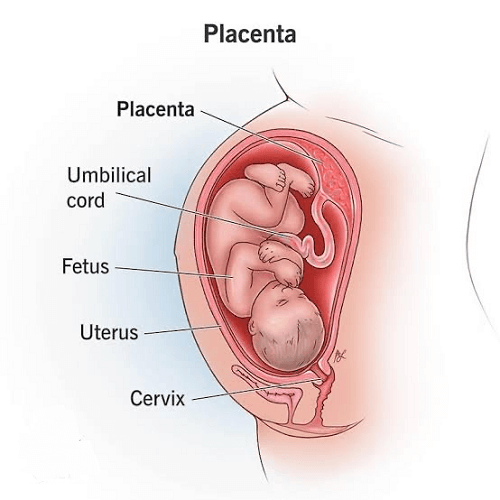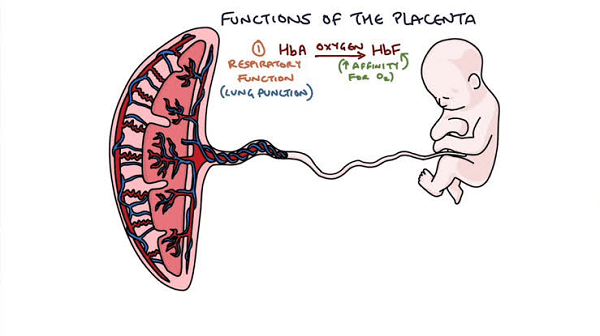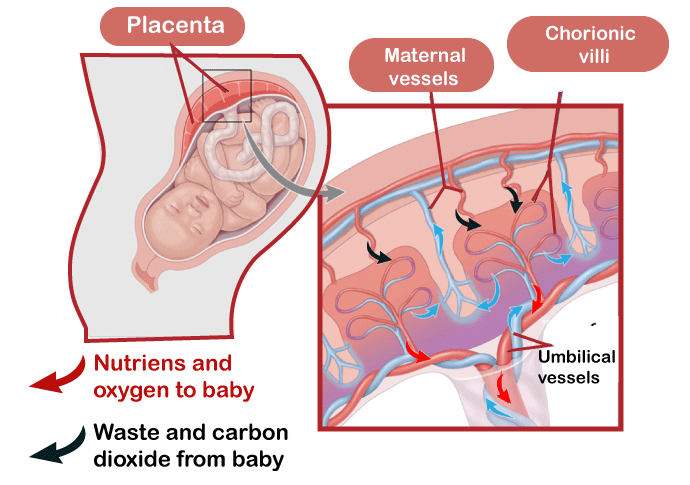Placenta DefinitionIn order to provide the developing fetus with nutrients, oxygen, and waste removal during pregnancy, the placenta grows. It is a complicated structure that develops from the mother's and the growing embryo's cells. The fertilized egg settles into the uterine lining early in pregnancy, where it starts to grow. On one side of the growing embryo, a group of cells known as the trophoblast starts to form. The development of the placenta depends in large part on this group of cells. 
Two distinct layers are formed as the trophoblast cells commence to divide and differentiate. The cells that will ultimately make up the fetal side of the placenta are being formed by further cell division and differentiation in the inner layer, also known as the cytotrophoblast. The syncytiotrophoblast, which is the outer layer, fuses with the uterine lining to create a multinucleated layer. The interchange of nutrients and waste materials between the mother and the growing fetus is carried out by the syncytiotrophoblast layer. It releases hormones that support pregnancy maintenance and stop the mother's immune system from fighting the growing embryo. The placenta develops into a highly vascularized organ with a plentiful blood flow as the pregnancy progresses. The uteroplacental circulation is formed as the mother's blood vessels in the lining of the uterus mature and spread out toward the growing placenta. The mother and the growing fetus can trade nutrients, oxygen, and waste products thanks to this circulation. Blood arteries are encircled by trophoblast cell layers on the fetal side of the placenta. These blood vessels transport oxygen-rich blood from the growing fetus to the placenta, where oxygen-poor blood-bearing waste materials are exchanged. The placenta is crucial in defending the growing fetus from dangerous substances. Many chemicals are prevented from passing from the mother's blood into the fetal bloodstream by this barrier, which serves as a barrier. But some substances, like booze and drugs, can pass through the placenta and hurt the growing fetus. Throughout pregnancy, the placenta keeps expanding and changing to meet the shifting demands of the growing fetus. As the fetus gets bigger and needs more nutrients toward the end of pregnancy, the placenta may become less effective at transferring substances from the mother's blood to the fetus. Complications like pre-eclampsia or fetal development restriction may result from this. The placenta is delivered as the "afterbirth" after the infant is born. Healthcare professionals typically check the placenta to make sure it was born whole and that no fragments were retained, which could cause an infection or other problems. In conclusion, the placenta is a sophisticated and crucial organ that grows during pregnancy in order to supply the developing fetus with nutrients, oxygen, and waste elimination. It is created from the mother's and the growing embryo's cells and is essential for shielding the fetus from dangerous substances. The placenta continues to change throughout pregnancy to meet the evolving requirements of the growing fetus, and it is delivered as the "afterbirth" after giving birth. Activities of PlacentaDuring pregnancy, the placenta, a temporary tissue, serves a variety of crucial functions. The placenta serves the following main purposes: 1. Nutritional interchange The placenta supplies the growing baby with nutrients like glucose, amino acids, and fatty acids. These minerals are crucial for the fetus's growth and development. 2. Oxygen transfer The placenta also makes it easier for the mother and the growing fetus to share oxygen. The placenta receives oxygen from the mother's blood, which is then converted to carbon dioxide and removed from the baby. 3. Waste disposal Waste products from the growing baby, such as carbon dioxide and urea, are eliminated by the placenta. These waste materials are removed from the fetus and cleared in the mother's bloodstream. 4. Hormone synthesis Human chorionic gonadotropin (hCG), estrogen, and progesterone are just a few of the chemicals the placenta makes. These chemicals support the pregnancy and get the body ready for delivery. 5. Immune protection The placenta also aids in defending the growing baby against infections. It generates antibodies that are passed from the mother to the baby, aiding in the fetus's defense against dangerous bacteria and viruses. 6. Barrier performance Between the mother's circulation and the fetal bloodstream, the placenta serves as a barrier. It stops dangerous compounds like booze and drugs from entering the fetal bloodstream and harming the growing fetus. 
7. Endocrine regulation The placenta controls the hormone amounts in the mother's blood. It aids in preserving the delicate hormonal equilibrium required for a healthy pregnancy. 8. Growth and development Throughout pregnancy, the placenta expands and changes to meet the changing requirements of the growing fetus. As the fetus matures and develops, it expands and becomes more effective at exchanging nutrients and wastes. 9. Pre-eclampsia prevention: Pre-eclampsia, a potentially fatal disease that can develop during pregnancy, is prevented by the placenta. It generates chemicals that assist in controlling blood pressure and preventing blood clots from developing. 10. Labor initiation: The placenta produces substances toward the close of pregnancy that aid at the beginning of labor. These substances cause the uterus' muscles to contract, aiding in the delivery of the infant. In conclusion, the placenta is a dynamic, intricate organ that performs a variety of significant roles during pregnancy. It helps to maintain the delicate hormonal balance in the mother's bloodstream, provides nutrients and oxygen to the growing fetus, removes waste, creates hormones, protects the fetus from infections, and produces waste products. Additionally, it helps to start labor at the end of pregnancy and prevents problems like pre-eclampsia. Types of PlacentaThere are different kinds of the placenta, and each has a special composition and feature. The four primary kinds are described below: 1. Diffuse Placenta This kind of placenta resembles a flat disk because the chorionic villi are evenly spaced across its complete surface. Animals like hogs, horses, and whales have diffuse placentas. 2. Cotyledonary Placenta The chorionic villi in this kind of placenta are organized in discrete, small patches called cotyledons that are ingrained in the maternal tissue. Normally, the cotyledons cover the complete surface of the placenta. Cows, sheep, and goats are examples of mammals that have cotyledonary placentas. 3. Zonary Placenta The chorionic villi create a ring around the placenta's center, or "zone," in this kind of placenta. The zone is connected to the uterus at its edges and encloses the growing fetus. Animals like canines and cats have zonary placentas. 4. Discoid Placenta The chorionic villi are localized in a single disc-shaped region on one side of the placenta, which is attached to the uterine wall, in this kind of placenta. The interchange of nutrients and gases between the mother and fetus takes place in the disc-shaped region. Humans, as well as other animals, can have discoid placentas. Based on the requirements of the specific species, each variety of placenta has special adaptations that enable it to provide the essential nutrients and gas exchange for the developing fetus. Structure of Placenta1. Introduction to placenta structure During pregnancy, the placenta, an organ in the form of a disc, grows in the uterus. It is made up of two major components: the decidua, which belongs to the mother, and the chorionic villi, which belong to the fetus. The placenta's structure is intended to shield the fetus from the mother's immune system while facilitating the exchange of nutrients and waste products between the mother and fetus. 2. Fetal Portion of the Placenta The chorionic villi, which are finger-like projections that develop from the embryo's topmost layer, the chorion, make up the fetal part of the placenta. The outer syncytiotrophoblast layer and the interior cytotrophoblast layer are the two layers that make up the chorionic villi. 
1. Maternal Portion of the Placenta The decidua, the dense, spongy layer of tissue that lines the uterus during pregnancy, makes up the maternal part of the placenta. The decidua is made up of two layers: the decidua parietalis, which lines the remainder of the uterus, and the decidua basalis, which is the portion of the decidua that comes into touch with the chorionic villi. 2. Membranes of the Placenta Multiple membrane layers that surround the placenta offer the developing fetus extra protection. These membranes include the chorion, which covers the amnion and forms the outermost layer of the embryo, and the amnion, which encloses the amniotic fluid that surrounds the fetus. 3. Placental Circulation The placenta has a rich network of blood vessels that allows for the exchange of nutrients and waste products between the mother and fetus. The fetal blood vessels are contained within the chorionic villi, while the maternal blood vessels are contained within the decidua. 4. Hormones in the Placenta Several chemicals that are produced by the placenta during pregnancy are vital for preserving pregnancy and getting the mother's body ready for labor. These hormones include progesterone, which helps to promote pregnancy, and human chorionic gonadotropin (HCG), which keeps the corpus luteum healthy and prevents menstruation. 5. Placental Function and Adaptations During pregnancy, the placenta goes through a number of changes to make sure the growing fetus gets the nutrients and oxygen it needs to expand and develop. Changes in blood flow, nutrient transport, and hormone production are a few of these adjustments. What Affects the Placenta's HealthDuring pregnancy, the placenta is essential to both fetal growth and the health of the mother. The health of the mother, her lifestyle decisions, and the environment can have an impact on the placenta's health. The following are the factors that can impact the placenta's health and the possible repercussions are also discussed below: 1. Maternal Health The placenta's health greatly depends on the mother's well-being. Women who already have illnesses like diabetes, hypertension, or autoimmune disorders are more likely to experience placental complications. These ailments can impair the placenta's capacity to deliver nutrients and oxygen to the fetus and remove waste, which can result in complications like fetal growth restriction, premature delivery, and stillbirth. 2. Lifestyle Choices Lifestyle choices can also impact the health of the placenta. Smoking, alcohol consumption, and drug use during pregnancy can cause damage to the placental tissue, reducing its ability to function correctly. This can lead to complications such as low birth weight, preterm birth, and placental abruption. 3. Maternal Age Another element that may have an impact on placental health is advanced maternal age. Preeclampsia and placental insufficiency are two maternal issues that are more common in women over the age of 35. These circumstances may have an impact on fetal growth and development, raising the possibility of stillbirth and preterm labor. 4. Infections The placenta's health can also be impacted by infections during pregnancy. Maternal infections like toxoplasmosis, group B streptococcus, and cytomegalovirus (CMV) can inflame the placental tissue and impair its ability to operate normally. Complications like preterm delivery and stillbirth may result from this. 5. Environmental Factors The health of the placenta can also be impacted by environmental variables such as air pollution, exposure to chemicals and pesticides, and maternal stress. These elements may lead to reactive stress and inflammation in the placental tissue, which would impair proper function. Complications like preterm delivery, fetal development restriction, and stillbirth may result from this. 6. Unusual Placental development The placenta occasionally experiences aberrant development that can affect both its health and function. For instance, placenta previa, in which the placenta covers the cervix, can result in bleeding and delivery difficulties. A hysterectomy is necessary in cases of placenta accreta, in which the placenta grows too deeply into the uterine wall and causes significant bleeding during delivery. 7. Complications The placenta's health can be impacted by issues like preeclampsia, maternal diabetes, and hypertension. These ailments can harm the placental tissue's blood vessels, decreasing the capacity of the tissue to deliver nutrients and oxygen to the fetus. Complications like fetal growth restriction, premature delivery, and stillbirth may result from this.
Next TopicPotential Difference Definition
|
 For Videos Join Our Youtube Channel: Join Now
For Videos Join Our Youtube Channel: Join Now
Feedback
- Send your Feedback to [email protected]
Help Others, Please Share









